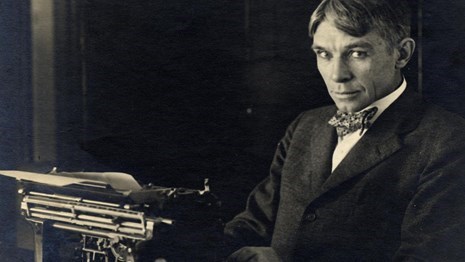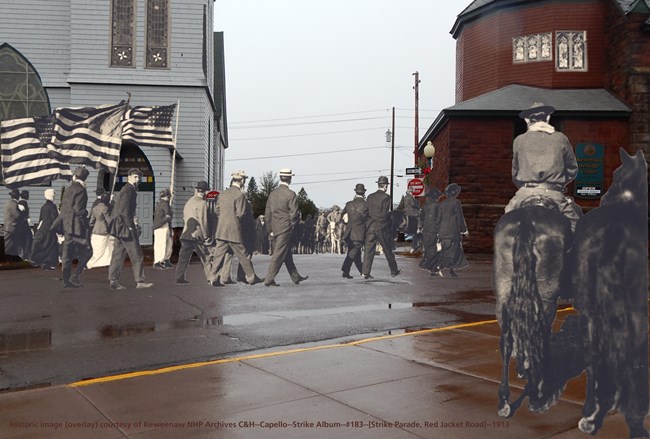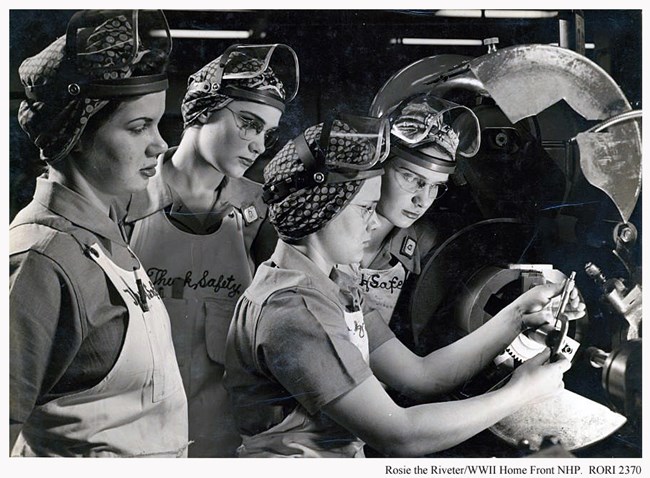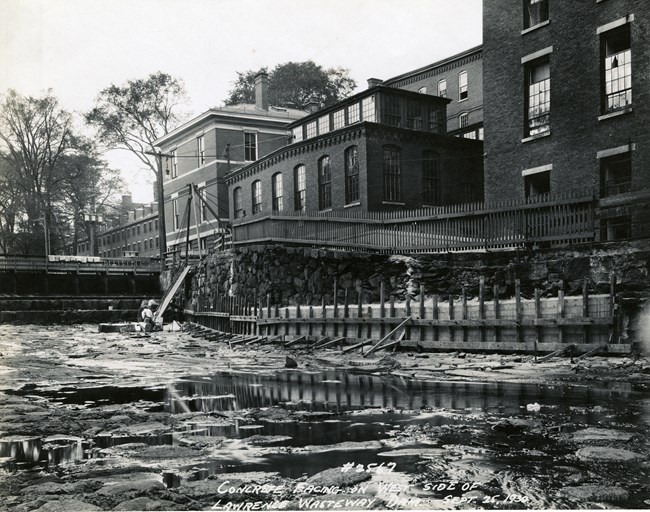Last updated: May 2, 2022
Article
NHD Article: Exploring Debates in Labor History Through the National Park System (2022)

Carl Sandburg at his typewriter. Courtesy of the Carl Sandburg National
Historic Site, National Park Service.
By Eleanor Mahoney, Ph.D., National Park Service Mellon Humanities Postdoctoral Fellow in the History of Labor and Productivity
Of my city the worst that men will ever say is this: You took little children away from the sun and the dew, And the glimmers that played in the grass under the great sky,
And the reckless rain; you put them between walls To work, broken and smothered, for bread and wages, To eat dust in their throats and die empty-hearted For a little handful of pay on a few Saturday nights.
“They Will Say” by Carl Sandburg
When Carl Sandburg published his poem “They Will Say,” in 1916, the U.S. government estimated that some two million children under 16 worked in the country’s mines, mills, and factories, and on farms. As a labor reporter writing for local papers in Chicago, Sandburg witnessed frsthand the dangerous conditions faced by young people who toiled in the city’s streets and businesses. He also encountered the many activists and reformers who fought to end child labor, often through new laws and regulations. These eforts frequently faced hostility from employers, politicians, and the legal system. Ratifying and implementing any sort of labor protection proved difcult in industrializing America; indeed, it took until the 1930s for the federal government to enforce child labor protections. Even then, schoolage children continued to work for wages, especially in agricultural settings.
The enactment of child labor laws ofers one example of a historical debate over work regulation in the United States. Legislation governing the workplace, whether about wages, hours, or rules for health and safety, was hotly contested in U.S. history. So too have been the rights of workers to organize unions and bargain collectively. Job sites have long been a space of civil rights struggles, with diverse groups of workers mobilizing to challenge discrimination and bias.
Labor history ofers students an excellent opportunity to explore the National History Day® (NHD) theme of Debate & Diplomacy in History: Successes, Failures, Consequences in all its complexity by considering the people, places, events, and actions that shaped when, where, and how Americans made a living. In the U.S. Congress, on a factory foor, or along a picket line, workers, employers, and government ofcials have engaged in spirited debates over wages, hours, and other working conditions. Diplomacy has been essential to addressing these disputes, as contending groups seek to fnd common ground on a piece of legislation, a union contract, or a health and safety regulation. Exploring why some attempts to fnd agreement succeeded while others failed, and the consequences of these outcomes, is essential to understanding the history of work in the United States.
The National Park Service (NPS) preserves and protects many of the nationally signifcant places and resources that tell all Americans’ stories. Students interested in learning more about debate and diplomacy in labor and working-class history can do so at a variety of NPS units, as well as at partner locations, including National Heritage Areas. Some sites discuss the efects of early industrial development on workers’ lives and the surrounding community, including the natural environment. Other parks emphasize the union movement’s growth, including the history of strikes and other workplace actions. Struggles for civil rights at work can be examined in these spaces as well. Agricultural labor, domestic labor, and transportation, such as railroad and canal construction, are prominent themes within the NPS system.
At these places, debates from the past still have resonance today. Who is responsible if a worker is injured on the job? How has immigration shaped work sites? What is the best manner to regulate pollution from factories or farms? How many hours should there be in a workday? What role should the government play in union elections or strikes? How should sites of labor confict or violence be marked? These questions have elicited various views and perspectives throughout U.S. history and could be ideal for examining potential subjects for NHD research centered on diplomacy and confict resolution.
This article presents several examples of lesson plans and other materials created by NPS staff related to labor history. They were chosen to refect a diversity of stories from NPS and partner sites. All can be connected to the NHD theme of Debate & Diplomacy in History: Successes, Failures, Consequences.
Carl Sandburg Home National Historic Site (North Carolina)
Known as the “Poet of the People,” Carl Sandburg hronicled working men and women’s lives in his ublications and performances. Born in 1878 to Swedish mmigrants, Sandburg left school at age 13 to help support is family. He later won numerous awards for his writing, hich often documented the efects of industrialization and rbanization on the United States. Sandburg and his wife, aula Steichen Sandburg, lived for over two decades at onnemara, a 245-acre farm in Flat Rock, North Carolina. he site is now part of the National Park System.
Problems and Perspectives
In this lesson, students examine debates over child labor drawn from early twentieth-century America. A collection of historic images generates discussion on the topic. Part of the lesson asks students to present the conficting views (of children, elected ofcials, parents, employers, journalists, and social reformers) to one another in a debate format. Students interested in this topic could consider why it took so long for the U.S. federal government to address child labor and how reformers changed their strategies over time. Or, they might examine how reform advocates employed diplomacy to negotiate new protective legislation.

Courtesy of Keweenaw NHP Archives.
Keweenaw National Historical Park (Michigan)
Michigan’s Keweenaw Peninsula is home to some of the most extensive copper deposits in the world. Indigenous peoples have been mining copper in the region for millennia, making beads, tools, and other items for use and trade. When Europeans arrived in the area, they learned of the copper resources from the Ojibwe people. In the mid-nineteenth century, new technology and increased demand led to a copper rush in northern Michigan. Boom and bust cycles followed, but the industry remained active for decades, enduring well into the twentieth century.
Studying History: The Copper Strike of 1913–1914
This video follows a middle-school student and a college professor as they learn about the history of an early twentieth-century strike by copper miners on the Keweenaw Peninsula, as well as the intense emotions the strike precipitated among residents. Some supported the decision to strike as the best means to improve their lives and livelihoods, while others worried about losing wages, health care, and company-owned housing. The flm documents the student’s use of primary sources, including photographs, historic newspapers, and union and government records. It also examines the strike’s long-term consequences, which still resonate in the region today. Students interested in the history of copper mining can hear from the workers themselves by listening to interviews from the park’s extensive oral history collection. Watch and listen to excerpts provided through the “Working Wednesday” interview series.
New Orleans Jazz National Historical Park (Louisiana)
Established to commemorate and share the story of jazz music, New Orleans Jazz National Historical Park hosts concerts, ofers educational programming, and preserves sites and stories associated with the origins and growth of this distinctively American art form. Jazz had its roots in New Orleans and continues to shape the city and its residents today.
Flambeaux Gleaux: The New Orleans Mardi Gras Flambeaux Strike of 1946.
In this lesson, students learn about how collective action can support social change. They are asked to consider why workers mobilize together to support a cause and what approaches or tactics might be most efective in achieving a goal. Students also explore the ways debates over workplace issues, such as wages, might be connected to broader movements for justice and equality. The focus is a 1946 strike by Flambeaux (torch carriers) in New Orleans. This workforce of African American men, many of them World War II veterans, carried faming torches to light Mardi Gras parades. The Flambeaux, who were paid a fat rate of $2.00 per march, asked for an increase to $5.00, a demand rejected by march organizers. In response, the workers went on strike, leaving the parade routes dark during the 1946 Mardi Gras festivities. By 1947, march organizers hiked wages to $4.00 per parade. Involvement in Mardi Gras events had long been shaped by race, gender, and social class, with the strike highlighting long-standing inequities.
![Interview with Cesar Chavez. 4/20/1979. [Chavez gesturing] Interview with Cesar Chavez. 4/20/1979. [Chavez gesturing]](/articles/000/images/service-pnp-ppmsca-40900-40916r.jpg?maxwidth=650&autorotate=false)
Retrieved from the Library of Congress.
César E. Chávez National Monument (California)
César E. Chávez led farm workers and supporters to establish the country’s frst permanent agricultural union, the United Farm Workers of America (UFW). His leadership brought sustained international attention to farmworkers and their families’ conditions, including low wages, exposure to pesticides, and deteriorated housing. The National Monument preserves Chávez’s home and fnal resting place. It is also the national headquarters of the UFW.
The César Chávez Educator Toolkit
This toolkit is a collection of lesson plans, classroom activity handouts, primary sources, technology-based activities, and resources for K-12 teachers. It provides educators with step-by-step guidance to design, implement, and deliver informative lessons about the life and work of César E. Chávez. Students will learn about the struggles faced by farmworkers and the organizing eforts of the UFW to improve working and living conditions. Many employers and politicians opposed the creation of a union for farm workers, and, in response, the UFW employed a variety of tactics to achieve the goal of collective bargaining. UFW members went on strike, promoted product boycotts, and held marches. Chávez and other union leaders also engaged in extensive talks with growers and lawmakers, negotiating complex contracts that necessitated fnesse, grit, and determination.

Courtesy of Rosie the Riveter/WWII Home Front NHP. RORI 2370
Gateway National Recreation Area (New York and New Jersey)
This park spans 27,000 acres from Sandy Hook, New Jersey, to Queens, New York. It protects a unique array of natural, historic, and recreational resources, including nesting areas for shorebirds, historic forts, public beaches, and land that served as New York City’s frst municipal airport. Designated by the U.S. Congress in 1972, Gateway National Recreation Area played an important part in expanding the presence of NPS in urban areas.
Women at Floyd Bennett Field
During World War II, millions of American women took on new jobs, including those in defense industries and manufacturing. These experiences transformed their lives and society leading to debates over gender roles in the workplace and the home. What did the media, politicians, and diverse groups of women say about the changes? When the war ended, what options remained open to female workers? This teacher’s guide includes materials that will introduce students to the World War II home front, emphasizing women and labor, highlighting both the opportunities and the conficts generated by women’s changing place in the workforce. It includes materials for reading, discussing, and refecting on the biographies of four women who were employed at Floyd Bennett Field, now part of Gateway National Recreation Area.
Rosie the Riveter WWII Home Front National Historical Park (California)
Interested in learning more about the experiences of diverse groups of women workers on the home front during World War II? The Rosie the Riveter World War II Home Front National Historical Park has produced an excellent flm on the subject, Home Front Heroes. The movie provides a comprehensive introduction to the World War II home front, explores the local story of the boomtown of Richmond, California, and features interviews with many “Rosies” and other home front workers.

Courtesy
of Lowell National Historical Park, National Park Service.
Loewell National Historical Park (Massachusetts)
Lowell National Historical Park explores the long history of industrial development in the United States. It charts the rapid growth and then gradual waning of the textile industry in New England. The park preserves the physical landscape and technology of textile manufacturing as well as the human stories of factory work and community life. Visitors can learn about the experience of employment in a mill at diferent points in time and the actions workers took to improve their working conditions, such as the Lowell Mill Girl Strike of 1836.
Who Polluted the Merrimack River?
Labor and environmental history are closely intertwined. Industrial development and resource extraction can have tremendous and lasting impacts on the natural world. How are these efects measured, and who is responsible for clean-up and restoration? Since the frst mills began operating in New England in the late eighteenth century, residents, mill owners, and workers have debated how pollution should be monitored and measured. These debates continue today, as individuals grapple with their impact on the environment. In this lesson plan, students learn about the Merrimack River in Massachusetts and consider how a community can identify and clean up harmful contaminants. Additional information on the river’s history and on its links to the textile industry is available at nps.gov/lowe/learn/historyculture/the-merrimack-river. htm.
Teaching Engaged Citizenship
This set of lesson plans introduces students to fve key concepts in civics education, centered on the continual give-and-take of the legislative process. The topics are “Amending the Constitution,” “Federalism,” “The Judicial System,” “Voting Rights,” and “First Amendment Freedoms.” Students will consider how access to political power has changed over time and how Americans can afect decision-making at the local, state, and federal government levels.
Conclusion
The feld of labor history is rich in stories for students to explore as part of their research into the National History Day theme of Debate & Diplomacy in History: Successes, Failures, Consequences. At the local, state, federal, and, indeed, international levels, labor regulations are frequently among the most contentious pieces of legislation under consideration. Lawmakers must balance many competing interests when drafting bills, using diplomatic skills to fnd common ground. The history of organized labor, especially contract negotiations, is also worthy of investigation. If workers and employers cannot agree on terms, the consequences might be a strike or lockout. Researching cases where negotiations succeeded or failed ofers students a chance to understand diplomacy’s implications in a workplace setting. Other aspects of labor history also relate to this year’s NHD theme. For example, debates over the short- and long-term environmental efects of industrial development are areas where students can compare clashing perspectives. All National Park units have a labor story, making them ideal settings to consider how debate and diplomacy have shaped labor history.
To access more theme resources, go to nhd.org/themebook.
